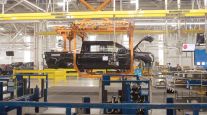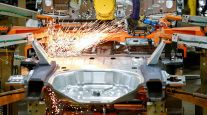American Factories Expand at Slowest Pace in More Than Two Years

Manufacturing in the United States expanded in August at the slowest pace since May 2013 as anemic demand from emerging markets such as China translated into leaner factory order books.
The Institute for Supply Management’s index fell to 51.1, lower than the Bloomberg News survey median, from 52.7 in July, a report from the Tempe, Arizona-based group showed Sept. 1. A measure of exports matched the weakest reading since April 2009.
The dollar’s ascent, which has accelerated since the middle of last year, is making it tougher for U.S. producers to drum up overseas sales, prompting plants to slow hiring and production. While factories are finding some relief with robust car sales and a recent rebound in investment in new equipment, record inventory building in the first half of 2015 is an added hurdle.
“The hits from the strong dollar and the unfavorable global demand backdrop continue to dampen U.S. manufacturing sector activity,” Millan Mulraine, deputy head of research and strategy at TD Securities USA in New York, said before the report. “Manufacturing is growing but just growing at a slower pace. The uncertainty is going to show up more in the fourth-quarter numbers.”
The weak data for manufacturing surface ahead of the Federal Reserve’s September policy meeting in which it will debate whether the United States is strong enough to withstand an increase in interest rates in the face of fragile overseas economies.
In China, the government’s official factory gauge dropped to a three-year low in August, while measures for the euro area signaled a divergence in the German and French economies. An index for Germany expanded more than forecast, and a French measure showed contraction, according to Markit Economics. U.K. manufacturing growth cooled as export orders declined for a fifth month.
The U.S. ISM gauge is hovering above the reading of 50 that is the dividing line between expansion and contraction in the industries that make up around 12% of the economy. The median forecast in the Bloomberg survey called for 52.5 in August, with estimates ranging from 51 to 54.
The ISM group’s new orders gauge dropped to a more than two-year low of 51.7 from 56.5 the prior month. It marked the biggest decline since January, when shaky overseas economies and weaker business investment tied to a slowdown in the nation’s oil patch held factories back.
A measure of export orders decreased by 1.5 points to 46.5 in August, matching July 2012 as the lowest level since the depths of the recession. The gauge has been in expansionary territory just once this year.
Global economic malaise is prompting factory managers to slow the pace of hiring. ISM’s employment index declined to a four-month low of 51.2 from 52.7.
The report also showed the slowest rate of production growth since February 2014 as factories work off inventories, which shrank for a second month.
Stockpiles at American companies piled up in the first half of the year, posting the biggest back-to-back quarterly increases on record. Inventories climbed at a $121.1 billion annualized rate in the second quarter, helping the economy expand at a 3.7% pace, the Commerce Department revised data showed last week.
The surge in unsold goods is a double-edge sword for the nation’s factories because, while it propelled the economy last quarter, businesses probably will cut back on new orders until the inventories are worked down.
Fed policymakers are monitoring incoming data for a better read on the outlook.
New York Fed President William C. Dudley said Aug. 26 that turbulence in financial markets has made the case for a September move “less compelling to me than it was a few weeks ago.” Fed Vice Chairman Stanley Fischer kept the door open to an interest-rate rise next month, saying in a speech Aug. 29 that “with inflation low, we can probably remove accommodation at a gradual pace.”




